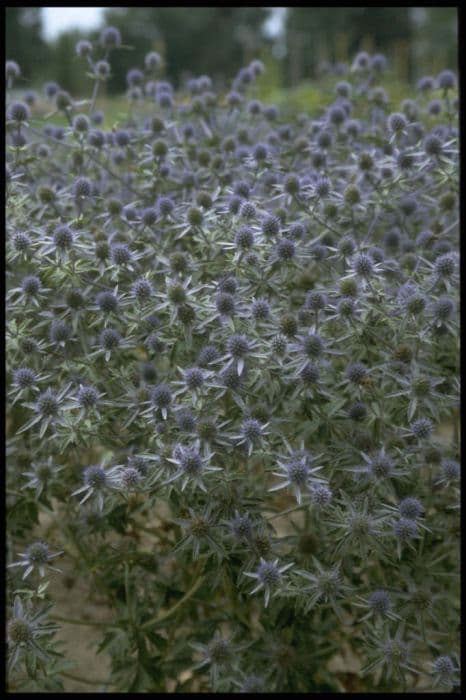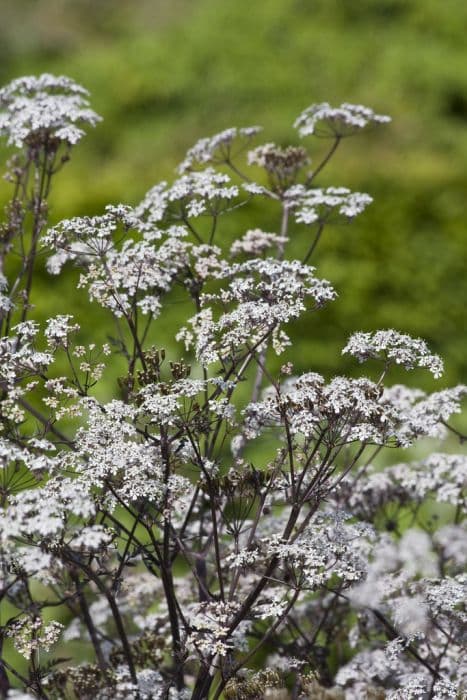Flat Sea Holly Eryngium planum 'Bethlehem'

ABOUT
Eryngium planum 'Bethlehem', commonly known as sea holly 'Bethlehem', is a striking perennial plant that is renowned for its unique appearance. The plant features a rosette of deep green, spiky leaves that have a somewhat thistle-like appearance. Its foliage is tough and leathery, creating a resilient base for the flowers. As for the flowers, they are the most remarkable feature of the sea holly 'Bethlehem'. They form in small, globular clusters at the tops of branching stems, creating a look that is reminiscent of a starry sky. Each flower head is surrounded by a spiky ruff of stiff bracts, which are often colored in a metallic blue or steely grey. These bracts can sometimes have a slightly purplish tinge, adding to the overall allure of the plant. The flower heads themselves are tightly packed with tiny flowers that have a similar blue or violet hue, and they resemble small spiny globes. This color palette gives the plant a cool and somewhat otherworldly look, which is particularly striking when set against the softer greens and blues of typical garden foliage. Furthermore, the textured stems that hold these blossoms aloft are sturdy and upright, with a wiry quality that adds a structural component to the plant's form. With its distinctive, almost sculptural flowers, sea holly 'Bethlehem' serves as an excellent focal point in gardens and as a visually interesting addition to floral arrangements. All in all, sea holly 'Bethlehem', with its combination of thistle-like leaves, metallic-hued flower bracts, and spiny blue blossoms, presents an eye-catching and unusual display that can captivate the attention of gardeners and plant enthusiasts alike.
About this plant
 Names
NamesFamily
Apiaceae
Synonyms
Flat Sea Holly, Blue Eryngo, Blue Devil
Common names
Eryngium planum.
 Toxicity
ToxicityTo humans
Eryngium planum, also known as Sea Holly, is not widely recognized as a poisonous plant to humans. There is limited information on its toxicity as it is generally not considered to be toxic. However, like with many plants, sensitive individuals may experience mild discomfort or an allergic reaction after handling or ingesting it. Due caution should be exercised to avoid any potential adverse effects.
To pets
Sea Holly is not commonly reported to be toxic to pets such as cats and dogs. As with humans, there is little information to suggest that Eryngium planum poses significant health risks to animals. Nevertheless, individual pets might have sensitivities that could lead to mild gastrointestinal upset if they ingest parts of the plant. As a general rule, it is wise to prevent pets from consuming plants that are not part of their normal diet to avoid any potential issues.
 Characteristics
CharacteristicsLife cycle
Perennials
Foliage type
Deciduous
Color of leaves
Green
Flower color
Blue
Height
2 feet (60 cm)
Spread
1 foot (30 cm)
Plant type
Herb
Hardiness zones
5
Native area
Europe
Benefits
 General Benefits
General Benefits- Attracts Pollinators: Eryngium planum 'Blue Glitter' draws bees and butterflies, aiding in pollination of gardens and crops.
- Drought Tolerance: Once established, it is very tolerant of dry conditions, requiring minimal watering.
- Deer and Rabbit Resistance: Its spiny texture and unique taste deter grazing by deer and rabbits, making it a good choice for areas with wildlife pressures.
- Low Maintenance: The plant does not need much attention once established, thriving even in poor soils, and requires little fertilization or pruning.
- Visual Interest: With its striking blue color and distinctive spiny texture, it adds visual contrast and interest to garden beds and borders.
- Long Blooming Season: It has a long flowering period from mid-summer to early fall, providing color for an extended period.
- Cut Flowers: The flowers make excellent cut flowers with a long vase life, suitable for floral arrangements.
- Dried Arrangements: It can be dried and used in everlasting flower arrangements, retaining its shape and color well.
- Herbaceous Perennial: As a perennial, it grows back year after year, giving a long-lasting display in the garden.
- Ornamental Seed Heads: After flowering, it forms ornamental seed heads that persist into winter, offering visual interest through multiple seasons.
 Medical Properties
Medical Properties- Anti-inflammatory: Eryngium planum may possess compounds that help reduce inflammation in the body.
- Diuretic effect: The plant has been traditionally used to promote urination, helping in the removal of excess fluids from the body.
- Antioxidant properties: Some studies suggest that extracts of Eryngium planum may contain antioxidants that combat oxidative stress.
- Antimicrobial activity: There is evidence that the plant has antibacterial and antifungal properties, potentially useful in treating infections.
 Air-purifying Qualities
Air-purifying QualitiesThis plant is not specifically known for air purifying qualities.
 Other Uses
Other Uses- Eryngium planum, commonly known as sea holly, can be used as a natural dye, imparting a blue or green hue to textiles depending on the mordant used.
- The flowers of sea holly can be used in dried floral arrangements, maintaining their shape and color for extended periods.
- The roots of sea holly, when roasted, have historically been used as a coffee substitute though it's not commonplace.
- Sea holly can serve as an architectural plant in garden design, providing striking form and texture to contemporary landscapes.
- The spiky nature of sea holly makes it a useful plant for adding to barriers or boundaries as a deterrent against foot traffic or animals.
- Sea holly can be used in crafting, particularly in creating intricate patterns or textures on paper or fabrics due to its unique flower head shape.
- The silver-blue stems and flower heads of the sea holly can be combined with metallic paints in art projects to create a natural "frost" effect.
- Fishermen have occasionally used the spiky bracts of sea holly as a makeshift tool for cleaning fish or as part of fishing lures.
- Sea holly can be used in a sensory garden as its distinctive texture provides a tactile experience for visitors.
- The silvery foliage and blue flowers are often used in summer weddings, providing a unique element to bouquets or table arrangements.
Interesting Facts
 Feng Shui
Feng ShuiThe Flat Sea Holly is not used in Feng Shui practice.
 Zodiac Sign Compitability
Zodiac Sign CompitabilityThe Flat Sea Holly is not used in astrology practice.
 Plant Symbolism
Plant Symbolism- Determination: Eryngium planum, commonly known as sea holly, features spiny leaves and a tough demeanor, symbolizing resilience and a fighting spirit against adversity.
- Independence: Sea holly's ability to thrive in poor soil and its self-sufficient nature represent self-reliance and individuality.
- Attraction: The unique blue color and architectural form are believed to exert a magnetic charm, making it a symbol of attraction and allure.
- Protection: With its prickly texture, sea holly is often associated with protection and defense, guarding against negative forces.
 Water
WaterThe Sea Holly should be watered deeply once the top inch of soil feels dry to the touch, which typically means watering about once a week during active growth periods. In hot, dry conditions, more frequent watering may be necessary, perhaps twice a week. Ensure the plant receives enough water to soak the roots but avoid waterlogging the soil. An approximate amount would be to use 1-2 gallons of water depending on the size of the plant and the environmental conditions, making sure that all parts of the root zone are adequately moistened.
 Light
LightSea Holly thrives in full sun conditions, requiring at least six hours of direct sunlight a day. The best spot for the plant would be in an unobstructed location where it can receive plenty of light throughout the day without shade.
 Temperature
TemperatureSea Holly prefers a temperature range between 60°F and 75°F for ideal growth conditions. However, it can withstand temperatures as low as 5°F in winter and as high as 90°F in summer. The plant is quite hardy when it comes to temperature fluctuations, making it suitable for a variety of climates.
 Pruning
PruningPruning Sea Holly is essential to remove spent flowers and encourage new growth, which can be done after the blooming period in late summer or early fall. Deadheading spent blossoms can also promote a second bloom. An annual pruning to cut back the plant to the ground in late winter or early spring will help maintain its shape and vigor.
 Cleaning
CleaningNot needed
 Soil
SoilFlat Sea Holly thrives in well-draining soil with a mix of two parts garden soil, one part sand or gravel, and one part compost. The ideal soil pH should be between 6.0 and 7.5.
 Repotting
RepottingFlat Sea Holly is not commonly repotted as it prefers to be left undisturbed; repot only if necessary and do so in spring every 3-4 years.
 Humidity & Misting
Humidity & MistingFlat Sea Holly tolerates a wide range of humidity levels but prefers drier conditions; avoid high humidity environments.
 Suitable locations
Suitable locationsIndoor
Place in bright light, minimal water, cool conditions.
Outdoor
Full sun, well-drained soil, protect from severe frosts.
Hardiness zone
5-9 USDA
 Life cycle
Life cycleEryngium planum 'Bethlehem', commonly known as Sea Holly or Bethlehem Blue, begins its life cycle as a seed, typically sown in late winter or early spring. The seeds germinate, often requiring a period of cold stratification, and seedlings emerge with their first set of true leaves. As the plant matures, it forms a rosette of spiny, metallic blue-green foliage at ground level. In the second year, the Sea Holly sends up flowering stems bearing distinctive blue or violet thistle-like flower heads by mid to late summer, which are attractive to pollinators such as bees and butterflies. After pollination, seeds develop and are dispersed by wind or collected for propagation. The plant is perennial and, after flowering, it will go dormant in winter, sprouting new growth from its rootstock with the onset of the next growing season.
 Propogation
PropogationPropogation time
Spring-Summer
Propogation: Eryngium planum 'Bethlehem', commonly known as Flat Sea Holly, is typically propagated by seed. The optimal time for sowing seeds is in late winter to early spring, when the threat of frost has passed. To propagate, seeds should be scattered on the surface of a well-draining soil mix and lightly pressed into the soil, but not covered as they require light for germination. The soil should be kept moist but not wet. Germination can be expected within two to three weeks at a temperature of 70°F (21°C). Once seedlings are large enough to handle, they can be transplanted into individual pots and later moved outdoors after the last frost. This variety of Eryngium is known for its drought tolerance and loves full sun, making it an excellent choice for xeriscaping or as a striking addition to a mixed border.









